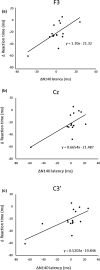Altered somatosensory evoked potentials associated with improved reaction time in a simple sensorimotor response task following repetitive practice
- PMID: 32583977
- PMCID: PMC7428476
- DOI: 10.1002/brb3.1624
Altered somatosensory evoked potentials associated with improved reaction time in a simple sensorimotor response task following repetitive practice
Abstract
Introduction: Repetitive practice of sensorimotor tasks is widely used for neurorehabilitation; however, it is unknown how practice alters sensory processing (e.g., recognition, discrimination, and attentional allocation) and associated cognitive processing, such as decision-making. The purpose of this study was to investigate whether long-latency somatosensory evoked potentials (SEPs) reflecting sensory processing, attention, and decision-making are altered by sensorimotor learning.
Methods: Fifteen participants performed a simple sensorimotor response task (thumb opposition in response to surface electrical stimulation), with experimental recording sessions before and after three days of practice. We then compared multiple SEP waveforms and reaction times (RTs) between pre- and postpractice trials.
Results: The RT was reduced after practice of three days, and we found a significant positive correlation between ΔRT and ΔN140lat at F3, Cz, and C3', ΔRT and ΔN250lat at F3, and there was a significant negative correlation between ΔRT and ΔP300amp at C3'.
Conclusion: The present study suggests that motor learning improves somatosensory processing and attentional allocation via neuroplasticity and that these alterations are reflected by specific SEP changes.
Keywords: N140; N250; P300; reaction time task; somatosensory evoked potentials.
© 2020 The Authors. Brain and Behavior published by Wiley Periodicals LLC.
Conflict of interest statement
None.
Figures






Similar articles
-
Effects of acute hypoxia on human cognitive processing: a study using ERPs and SEPs.J Appl Physiol (1985). 2017 Nov 1;123(5):1246-1255. doi: 10.1152/japplphysiol.00348.2017. Epub 2017 Jul 20. J Appl Physiol (1985). 2017. PMID: 28729388
-
Subclinical Neck Pain Leads to Differential Changes in Early Somatosensory Evoked Potentials in Response to a Novel Force Matching Tracking Task.J Integr Neurosci. 2024 Jan 15;23(1):10. doi: 10.31083/j.jin2301010. J Integr Neurosci. 2024. PMID: 38287858
-
Changes in the somatosensory N250 and P300 by the variation of reaction time.Eur J Appl Physiol. 2003 May;89(3-4):326-30. doi: 10.1007/s00421-003-0801-y. Epub 2003 Mar 18. Eur J Appl Physiol. 2003. PMID: 12736841 Clinical Trial.
-
Potentials evoked in human and monkey cerebral cortex by stimulation of the median nerve. A review of scalp and intracranial recordings.Brain. 1991 Dec;114 ( Pt 6):2465-503. doi: 10.1093/brain/114.6.2465. Brain. 1991. PMID: 1782527 Review.
-
Neurophysiological Changes Measured Using Somatosensory Evoked Potentials.Trends Neurosci. 2018 May;41(5):294-310. doi: 10.1016/j.tins.2018.02.007. Epub 2018 Mar 14. Trends Neurosci. 2018. PMID: 29549962 Review.
Cited by
-
[Research on feature classification of lower limb motion imagination based on electrical stimulation to enhance rehabilitation].Sheng Wu Yi Xue Gong Cheng Xue Za Zhi. 2021 Jun 25;38(3):425-433. doi: 10.7507/1001-5515.202007004. Sheng Wu Yi Xue Gong Cheng Xue Za Zhi. 2021. PMID: 34180187 Free PMC article. Chinese.
-
The Effect of Pedaling at Different Cadence on Attentional Resources.Front Hum Neurosci. 2022 Feb 25;16:819232. doi: 10.3389/fnhum.2022.819232. eCollection 2022. Front Hum Neurosci. 2022. PMID: 35280213 Free PMC article.
-
The impacts of training on change deafness and build-up in a flicker task.PLoS One. 2022 Nov 17;17(11):e0276157. doi: 10.1371/journal.pone.0276157. eCollection 2022. PLoS One. 2022. PMID: 36395252 Free PMC article.
-
Discrimination of the moving direction is improved depending on the pattern of the mechanical tactile stimulation intervention.BMC Neurosci. 2024 Mar 5;25(1):15. doi: 10.1186/s12868-024-00855-2. BMC Neurosci. 2024. PMID: 38443782 Free PMC article.
-
Event-Related Brain Potentials N140 and P300 during Somatosensory Go/NoGo Tasks Are Modulated by Movement Preparation.Brain Sci. 2023 Dec 30;14(1):38. doi: 10.3390/brainsci14010038. Brain Sci. 2023. PMID: 38248253 Free PMC article.
References
-
- Donchin, E. , & Coles, M. G. H. (1988). Is the P300 component a manifestation of context updating? Behavioral and Brain Sciences, 100, 357–374. 10.1017/S0140525X00058027 - DOI
-
- Gobbelé, R. , Lamberty, K. , Stephan, K. E. , Stegelmeyer, U. , Buchner, H. , Marshall, J. C. , … Waberski, T. D. (2008). Temporal activation patterns of lateralized cognitive and task control processes in the human brain. Brain Research, 1205, 81–90. - PubMed
Publication types
MeSH terms
Grants and funding
LinkOut - more resources
Full Text Sources
Research Materials
Miscellaneous

